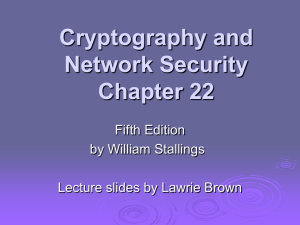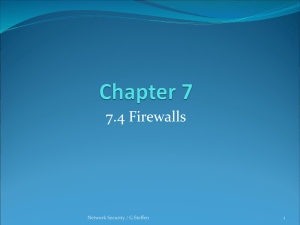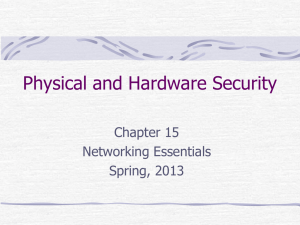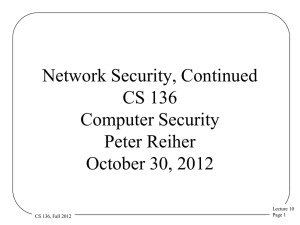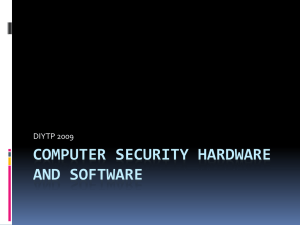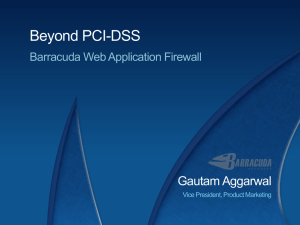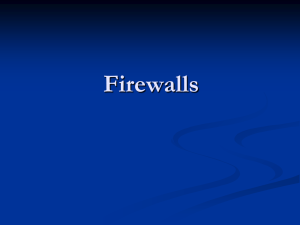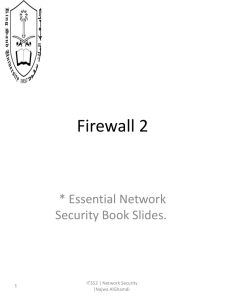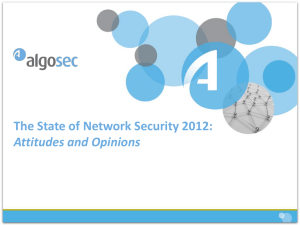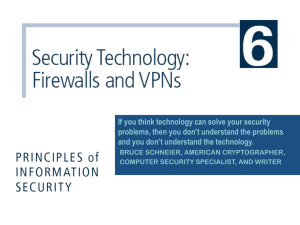William Stallings, Cryptography and Network Security 5/e
advertisement
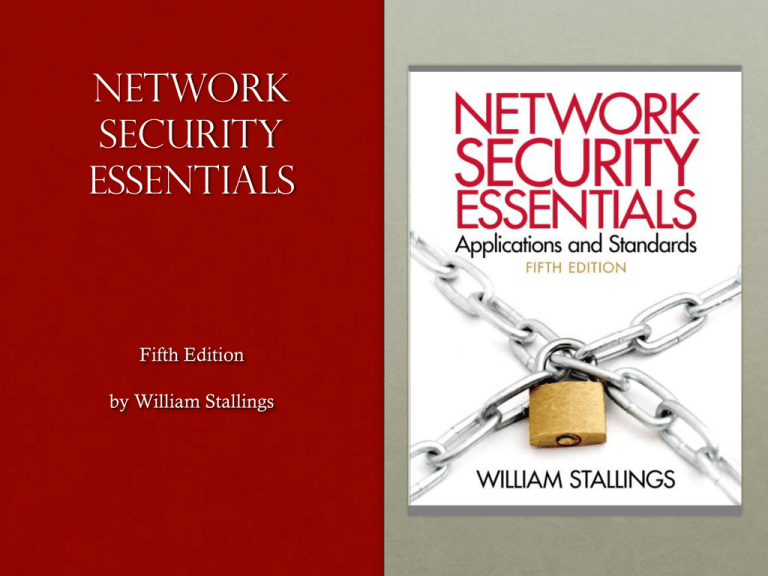
Network Security Essentials Fifth Edition by William Stallings Chapter 12 Firewalls The function of a strong position is to make the forces holding it practically unassailable. — On War, Carl Von Clausewitz On the day that you take up your command, block the frontier passes, destroy the official tallies, and stop the passage of all emissaries. —The Art of War, Sun Tzu The Need for firewalls • Internet connectivity is no longer optional for organizations • Individual users within the organization want and need Internet access • While Internet access provides benefits to the organization, it enables the outside world to reach and interact with local network assets • • This creates a threat to the organization While it is possible to equip each workstation and server on the premises network with strong security features, this may not be sufficient and in some cases is not cost-effective • Firewall • • • • An alternative, or at least complement, to host-based security services Is inserted between the premises network and the Internet to establish a controlled link and to erect an outer security wall or perimeter The aim of this perimeter is to protect the premises network from Internetbased attacks and to provide a single choke point where security and auditing can be imposed May be a single computer system or a set of two or more systems that cooperate to perform the firewall function Firewall characteristics • Design goals for a firewall: • All traffic from inside to outside, and vice versa, must pass through the firewall • Only authorized traffic, as defined by the local security policy, will be allowed to pass • The firewall itself is immune to penetration • Techniques that firewalls use to control access and enforce the site’s security policy: Service control • Determines the types of Internet services that can be accessed, inbound or outbound Direction control • Determines the direction in which particular service requests may be initiated and allowed to flow through the firewall User control • Controls access to a service according to which user is attempting to access it Behavior control • Controls how particular services are used Firewall expectations Defines a single choke point that keeps unauthorized users out of the protected network, prohibits potentially vulnerable services from entering or leaving the network, and provides protection from various kinds of IP spoofing and routing attacks Provides a location for monitoring security-related events A firewall Is a convenient platform for several Internet functions that are not security related Can serve as the platform for IPsec Firewall limitations Cannot protect against attacks that bypass the firewall A laptop, PDA, or portable storage device may be used and infected outside the corporate network, and then attached and used internally A Firewall Cannot guard against wireless communications between local systems on different sides of the internal firewall May not protect fully against internal threats, such as a disgruntled employee or an employee who unwittingly cooperates with an external attacker Table 12.1 Packet-Filtering Example Packet Filtering firewalls Weaknesses • Because packet filter firewalls do not examine upper-layer data, they cannot prevent attacks that employ application-specific vulnerabilities or functions • Because of the limited information available to the firewall, the logging functionality present in packet filter firewalls is limited • Most packet filter firewalls do not support advanced user authentication schemes • Packet filter firewalls are generally vulnerable to attacks and exploits that take advantage of problems within the TCP/IP specification and protocol stack • Due to the small number of variables used in access control decisions, packet filter firewalls are susceptible to security breaches caused by improper configurations Strengths • Its simplicity • Transparent to users and are very fast Attacks and countermeasures IP address spoofing Source routing attacks Tiny fragment attacks The intruder transmits packets from the outside with a source IP address field containing an address of an internal host The source station specifies the route that a packet should take as it crosses the internet, in the hopes that this will bypass security measures that do not analyze the source routing information The intruder uses the IP fragmentation option to create extremely small fragments and force the TCP header information into a separate packet fragment Countermeasure is to discard all packets that use this option Countermeasure is to enforce a rule that the first fragment of a packet must contain a predefined minimum amount of the transport header Countermeasure is to discard packets with an inside source address if the packet arrives on an external interface Table 12.2 Example Stateful Firewall Connection State Table [SCAR09b] Application Level Gateway • Also called an application proxy • Acts as a relay of application-level traffic • If the gateway does not implement the proxy code for a specific application, the service is not supported and cannot be forwarded across the firewall • The gateway can be configured to support only specific features of an application that the network administrator considers acceptable while denying all other features • Tend to be more secure than packet filters • Disadvantage: • The additional processing overhead on each connection Circuit-Level Gateway • Also called circuit-level proxy • Can be a stand-alone system or it can be a specialized function performed by an application-level gateway for certain applications • Does not permit an end-to-end TCP connection • The security function consists of determining which connections will be allowed • Typical use is a situation in which the system administrator trusts the internal users • Can be configured to support application-level or proxy service on inbound connections and circuit-level functions for outbound connections • Example of implementation is the SOCKS package Bastion Host • A system identified by the firewall administrator as a critical strong point in the network’s security • Typically serves as a platform for an application-level or circuit-level gateway • Common characteristics: • • • • • • • • • • Executes a secure version of its operating system, making it a hardened system Only the services that the network administrator considers essential are installed May require additional authentication before a user is allowed access to the proxy services Each proxy is configured to support only a subset of the standard application’s command set Each proxy is configured to allow access only to specific host systems Each proxy maintains detailed audit information by logging all traffic, each connection, and the duration of each connection Each proxy module is a very small software package specifically designed for network security Each proxy is independent of other proxies on the bastion host A proxy generally performs no disk access other than to read its initial configuration file Each proxy runs as a nonprivileged user in a private and secured directory on the bastion host Host-Based Firewall • A software module used to secure an individual host • Is available in many operating systems or can be provided as an add-on package • Filters and restricts the flow of packets • Common location is a server • Advantages: • Filtering rules can be tailored to the host environment • Protection is provided independent of topology • Used in conjunction with stand-alone firewalls, provides an additional layer of protection Personal Firewall • Controls the traffic between a personal computer or workstation on one side and the Internet or enterprise network on the other side • Can be used in the home environment and on corporate intranets • Typically is a software module on the personal computer • Can also be housed in a router that connects all of the home computers to a DSL, cable modem, or other Internet interface • Primary role is to deny unauthorized remote access to the computer • Can also monitor outgoing activity in an attempt to detect and block worms and other malware Figure 12.2 Example Personal Firewall Interface Summary of Firewall Locations and Topologies • • Host-resident firewall • This category includes personal firewall software and firewall software on servers • Can be used alone or as part of an in-depth firewall deployment • Single bastion T • Similar to single bastion inline but has a third network interface on bastion to a DMZ where externally visible servers are placed • Double bastion inline • DMZ is sandwiched between A single router between internal and external bastion firewalls Screening router • networks with stateless or full packet filtering • • This arrangement is typical for small office/home office (SOHO) applications Single bastion inline • A single firewall device between an internal and external router • This is the typical firewall appliance configuration for small-to-medium sized organizations • Double bastion T • DMZ is on a separate network interface on the bastion firewall • Distributed firewall configuration • Used by some large businesses and government organizations Summary • The need for firewalls • Firewall characteristics • Types of firewalls • Packet filtering firewall • Stateful inspection firewalls • Application level gateway • Circuit level gateway • Firewall basing • Bastion host • Host based firewalls • Personal firewall • Firewall locations and configurations • DMZ networks • Virtual private networks • Distributed firewalls • Firewall location and topologies summary
